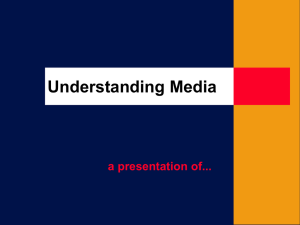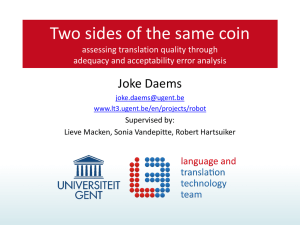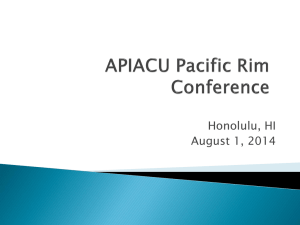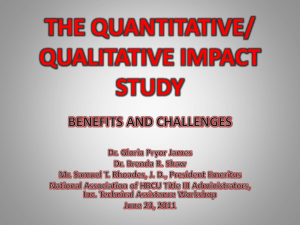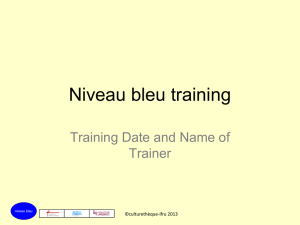Slide - MTE 2014
advertisement
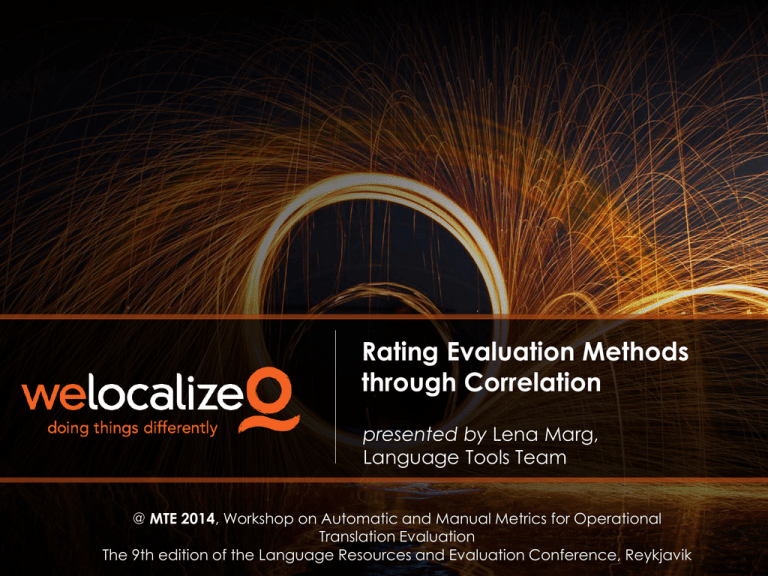
Rating Evaluation Methods through Correlation presented by Lena Marg, Language Tools Team @ MTE 2014, Workshop on Automatic and Manual Metrics for Operational Translation Evaluation The 9th edition of the Language Resources and Evaluation Conference, Reykjavik Background on MT Programs @ MT programs vary with regard to: Scope Locales Maturity System Setup & Ownership MT Solution used Key Objective of using MT Final Quality Requirements Source Content MT Quality Evaluation @ 1. Automatic Scores Provided by the MT system (typically BLEU) Provided by our internal scoring tool (range of metrics) 2. Human Evaluation Adequacy, scores 1-5 Fluency, scores 1-5 3. Productivity Tests Post-Editing versus Human Translation in iOmegaT The Database Objective: Establish correlations between these 3 evaluation approaches to - draw conclusions on predicting productivity gains - see how & when to use the different metrics best Contents: - Data from 2013 - Metrics (BLEU & PE Distance, Adequacy & Fluency, Productivity deltas) - Various locales, MT systems, content types - MT error analysis - Post-editing quality scores Method Pearson’s r If r = +.70 or higher +.40 to +.69 +.30 to +.39 +.20 to +.29 +.01 to +.19 -.01 to -.19 -.20 to -.29 -.30 to -.39 -.40 to -.69 -.70 or higher Very strong positive relationship Strong positive relationship Moderate positive relationship Weak positive relationship No or negligible relationship No or negligible relationship Weak negative relationship Moderate negative relationship Strong negative relationship Very strong negative relationship thedatabase Data Used 27 locales in total, with varying amounts of available data + 5 different MT systems (SMT & Hybrid) correlationresults Adequacy vs Fluency Fluency and Adequacy - All Locales 5 Fluency 4 3 2 1 1.00 2.00 3.00 4.00 5.00 Adequacy A Pearson’s r of 0.82 across 182 test sets and 22 locales is a very strong, positive relationship COMMENT - most locales show a strong correlation between their Fluency and Adequacy scores - high correlation is expected (with in-domain data customized MT systems) in that, if a segment is really not understandable, it is neither accurate nor fluent. If a segment is almost perfect, both would score very high - some evaluators might not differentiate enough between Adequacy & Fluency, falsely creating a higher correlation correlationresults Adequacy and Fluency versus BLEU 60 BLEU Score BLEU Score 80 40 20 0 1 2 3 4 5 80 70 60 50 40 30 20 10 0 1 2 3 4 5 Adequacy Score Fluency Score Fluency and BLEU across locales have a Pearson’s r of 0.41, a strong positive relationship Adequacy and BLEU across locales have a Pearson’s r of 0.26, a moderately positive relationship Pearson's r Adequacy, Fluency & BLEU Correlation - All Locales 1.00 0.80 0.60 0.40 0.20 0.00 -0.20 -0.40 -0.60 -0.80 -1.00 da_DK de_DE es_ES es_LA fr_CA fr_FR Adequacy & BLEU it_IT ja_JP ko_KR pt_BR ru_RU zh_CN Fluency & BLEU Adequacy, Fluency and BLEU correlation for locales with 4 or more test sets* correlationresults Adequacy and Fluency versus PE Distance PE Distance PE Distance 80% 60% 40% 20% 0% 1 2 3 4 5 90% 80% 70% 60% 50% 40% 30% 20% 10% 0% 1 2 Fluency Score 3 4 5 Adequacy Score Fluency and PE distance across all locales have a cumulative Pearson’s r of -0.70, a very strong negative relationship Adequacy and PE distance across all locales have a cumulative Pearson’s r of 0.41, a strong negative relationship A negative correlation is desired: as Adequacy and Fluency scores increase, PE distance should decrease proportionally. Adequacy, Fluency and PE Distance Correlation 1.00 0.80 0.60 0.40 0.20 0.00 -0.20 -0.40 -0.60 -0.80 -1.00 de_DE es_ES/LA fr_FR/CA Adequacy & PE Distance it_IT Fluency & PE Distance pt_BR correlationresults Adequacy and Fluency versus Productivity Delta Productivity Delta and Adequacy 100% 100% 80% 80% Productivity Delta Productivity Delta Productivity Delta and Fluency 60% 40% 20% 40% 20% 0% 0% 1 -20% 60% 2 3 4 5 Human Evaluation Fluency Score (1-5) Productivity and Fluency across all locales with a cumulative Pearson’s r of 0.71, a very strong correlation 1 -20% 2 3 4 5 Human Evaluation Adequacy Score (1-5) Productivity and Adequacy across all locales with a cumulative Pearson’s r of 0.77, a very strong correlation correlationresults Automatic Metrics versus Productivity Delta Productivity delta and BLEU with a cumulative Pearson’s r of 0.24, a weak positive relationship Productivity delta as a % BLEU & Productivity Delta 200% 100% 0% 0 10 20 30 40 50 -100% 60 70 80 90 100 BLEU Score Productivity Delta and PE Distance Productivity Delta as % 200% 100% 0% 0% -100% 10% 20% 30% 40% 50% 60% Post-Edit Distance 70% 80% 90% 100% With a Pearson’s r of 0.436, as PE distance increases, indicating a greater effort from the post-editor, Productivity declines; it is a strong negative relationship correlationresults Summary Pearson's r Variables Strength of Correlation Tests (N) Locales Statistical Significance value <) 0.82 Adequacy & Fluency Very strong positive relationship 182 22 0.0001 0.77 Adequacy & P Delta Very strong positive relationship 23 9 0.0001 0.71 Fluency & P Delta Very strong positive relationship 23 9 0.00015 0.55 Cognitive Effort Rank & PE Distance Strong positive relationship 16 10 0.027 0.41 Fluency & BLEU Strong positive relationship 146 22 0.0001 0.26 Adequacy & BLEU Weak positive relationship 146 22 0.0015 0.24 BLEU & P Delta Weak positive relationship 106 26 0.012 0.13 Numbers of Errors & PE Distance No or negligible relationship 16 10 ns -0.30 Predominant Error & BLEU Moderate negative relationship 63 13 0.017 -0.32 Cognitive Effort Rank & PE Delta Moderate negative relationship 20 10 ns -0.41 Numbers of Errors & BLEU Strong negative relationship 63 20 0.00085 -0.41 Adequacy & PE Distance Strong negative relationship 38 13 0.011 -0.42 PE Distance & P Delta Strong negative relationship 72 27 0.00024 -0.70 Fluency & PE Distance Very strong negative relationship 38 13 0.0001 -0.81 BLEU & PE Distance Very strong negative relationship 75 27 0.0001 (p takeaways CORRELATIONS The strongest correlations were found between: Adequacy & Fluency BLEU and PE Distance Adequacy & Productivity Delta Fluency & Productivity Delta Fluency & PE Distance The Human Evaluations come out as stronger indicators for potential post-editing productivity gains than Automatic metrics. erroranalysis Error Type Frequency 25% 20% 15% 10% 5% 0% 20% 16% 12% 12% 8% 2% 3% 3% 5% 5% 7% 1% 1% 3% 2% Data size: 117 evaluations x 25 segments (3125 segments), includes 22 locales, different MT systems (hybrid & SMT). Taking this “broad sweep“ view, most errors logged by evaluators across all categories are: - Sentence structure (word order) - MT output too literal - Wrong terminology - Word form disagreements - Source term left untranslated erroranalysis Similar picture when we focus on the 8 dominant language pairs that constituted the bulk of the evaluations in the dataset. takeaways MOST FREQUENT ERRORS LOGGED Across different MT systems, content types AND locales, 5 error categories stand out in particular. Questions: How (if) do these correlate to the post-editing effort and predicting productivity gains? How (if) can the findings on errors be used to improve the underlying systems? Are the current error categories what we need? Can the categories be improved for evaluators? Will these categories work for other post-editing scenarios (e.g. light PE)? takeaways Remodelling of Human Evaluation Form to: - increase user-friendliness - distinguish better between Ad & Fl errors - align with cognitive effort categories proposed in literature - improve relevance for system updates E.g.“Literal Translation“ seemed too broad and probably over-used. nextsteps o focus on language groups and individual languages: do we see the same correlations? o focus on different MT systems o add categories to database (e.g. string length, post-editor experience) o add new data to database and repeat correlations o continuously tweak Human Evaluation template and process, as it proofs to provide valuable insights for predictions, as well as posteditor on-boarding / education and MT system improvement o investigate correlation with other AutoScores (…) THANK YOU! lena.marg@welocalize.com with Laura Casanellas Luri, Elaine O’Curran, Andy Mallett
